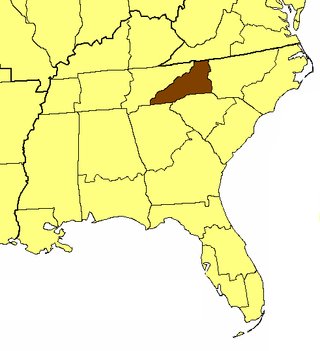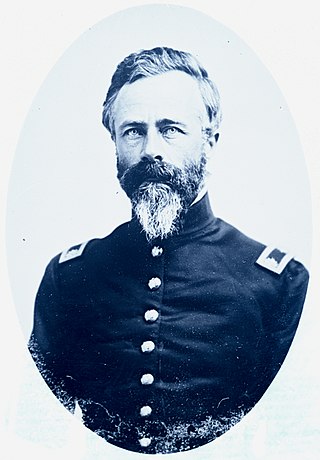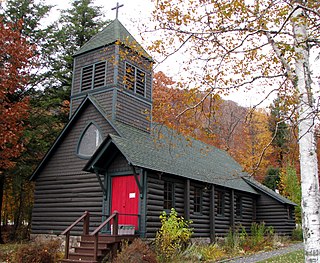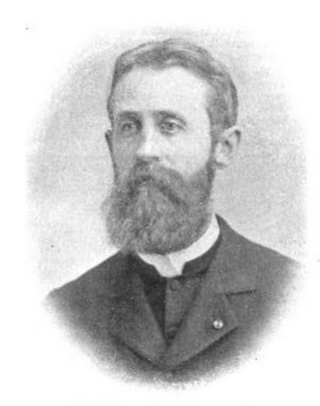
Evergreen is an unincorporated town, a post office, and a census-designated place (CDP) located in and governed by Jefferson County, Colorado, U.S. The CDP is a part of the Denver–Aurora–Lakewood, CO Metropolitan Statistical Area. The Evergreen post office has the ZIP Codes 80439 and 80437. At the 2020 census, the population of the Evergreen CDP was 9,307. The Evergreen Metropolitan District provides services.
Midtown is a collection of neighborhoods in Memphis, Tennessee, to the east of Downtown.

The Episcopal Diocese of Western North Carolina is a diocese in the Episcopal Church. It consists of 28 counties in western North Carolina and its episcopal see is in Asheville, North Carolina, seated at Cathedral of All Souls. The first recorded worship from the Book of Common Prayer west of the Catawba River was in 1786. Valle Crucis, where one of the two conference centers is located, began as a missionary outpost in 1842. In 1894, a resolution was adopted in the Convention of the Diocese of North Carolina that the Western part of the state be set aside and offered to the General Church as a Missionary District. The following year, in November 1895, the first Convention of the District of Asheville was held at Trinity Church in Asheville. In 1922, after all the requirements had been fulfilled, a petition from the Jurisdiction of Asheville to become the Diocese of Western North Carolina was presented at the General Convention of The Episcopal Church. It was accepted on September 12, 1922.

Orkney Springs is a CDP in western Shenandoah County, Virginia, United States. The reason for the name "Orkney" is unknown, but believed to be tied to either the Orkney Islands off the coast of Scotland or to the Earl of Orkney, since one of the earliest European landowners was Dr. John McDonald, a Scottish physician. The "Springs" part of the name comes from the numerous underground mineral springs in the area. Major Peter Higgins laid out the town in 1808, with a common area surrounded by lots; later archeological research found relics of prior Native American use of the site.

The Lariat Loop National Scenic and Historic Byway is a National Scenic Byway and a Colorado Scenic and Historic Byway located in Jefferson County, Colorado, USA. The byway is a 40-mile (64 km) loop in the Front Range foothills west of Denver through Golden, Lookout Mountain Park, Genesee Park, Evergreen, Morrison, Red Rocks Park, and Dinosaur Ridge. The Lariat Loop connects to the Mount Evans Scenic Byway at Bergen Park.

Jules Jacques Benois Benedict was one of the most prominent architects in Colorado history, whose works include a number of well-known landmarks and buildings listed on the National Register of Historic Places.

Bergen Park is a park near Evergreen, Colorado. It is on the National Register of Historic Places.

Thomas R. Williams was an American antebellum-era Army officer and a brigadier general in the Union Army during the Civil War. He was killed as he commanded the Union troops at the Battle of Baton Rouge.

The Chapel of the Transfiguration is a small log chapel in Grand Teton National Park, in the community of Moose. The chapel was sited and built to frame a view of the Cathedral Group of peaks in a large window behind the altar. The chapel, which was built in 1925, is owned and operated by St. John's Episcopal Church in Jackson.

Cañon City Downtown Historic District is a historic district in Cañon City, Colorado. It was listed on the National Register of Historic Places in 1983. The historic district listing was based on a 1981 survey by city staff; a 2004-05 survey has been completed which updates and expands upon it.

Church of the Transfiguration is a historic Episcopal church located at Blue Mountain Lake in Hamilton County, New York. It is a small, one story, gable roofed structure with a central belfry at the west end. The building was built in 1885 and is constructed of barked spruce logs, mitred at the corners, and set upon a high foundation of random fieldstone. The church features Tiffany glass windows and a Meneely bell donated by Mrs. Levi P. Morton wife of future Vice-President under Benjamin Harrison.

The Church of the Holy Communion is a historic Episcopal church building on Summit Street in Norwood, Bergen County, New Jersey, United States.

The Church of St. Philip-in-the-Field and Bear Canon Cemetery is a historic church building and cemetery in Sedalia, Colorado. It was added to the National Register of Historic Places in 1973.

Gershom Mott Williams was an American bishop. He was the first Episcopalian bishop of Marquette. He was a church journalist, author, and translator. Williams graduated from Cornell University and received his master's degree and Doctor of Divinity degree from Hobart College. Although he passed the bar in 1879, Williams began an extensive career in the Episcopal Church, having positions in Buffalo, Milwaukee, and Detroit before becoming a bishop. He was involved in many church commissions, including the preparation of and attendance at the Lambeth Conference of 1908.

Taylor Memorial Chapel at La Foret Conference and Retreat Center is a historic chapel in Black Forest, Colorado. It is a National Register of Historic Places listing.

Cheyenne Mountain is a triple-peaked mountain in El Paso County, Colorado, southwest of downtown Colorado Springs. The mountain serves as a host for military, communications, recreational, and residential functions. The underground operations center for the North American Aerospace Defense Command (NORAD) was built during the Cold War to monitor North American airspace for missile launches and Soviet military aircraft. Built deep within granite, it was designed to withstand the impact and fallout from a nuclear bomb. Its function broadened with the end of the Cold War, and then many of its functions were transferred to Peterson Air Force Base in 2006.

The Diocese of Colorado is the diocese of the Episcopal Church which covers all of Colorado. It is in Province VI. Its cathedral, Saint John's Cathedral, Denver, is located in Denver, along with its offices. John Franklin Spalding was the first bishop of the diocese. Kimberly "Kym" Lucas is the current bishop.

Josepha Williams Douglas (1860–1938), also commonly known as Josepha Williams, was a physician and co-operator of the Marquette-Williams Sanitarium in Denver, Colorado. She was one of the first female doctors in the state. She, as well as her mother Mary Neosho Williams, purchased a number of tracts of land in the Evergreen, Colorado area, at least some of which were ultimately donated for the Evergreen Conference District. Douglas was the daughter of Civil War General Thomas Williams and wife of Canon Charles Winfred Douglas, a plainsong musical expert and Episcopalian priest.

The Hiwan Homestead Museum is a historic house museum in Evergreen, Colorado.



















